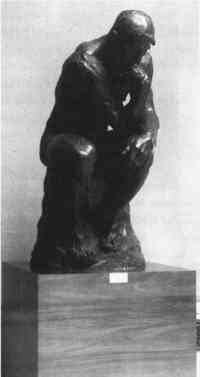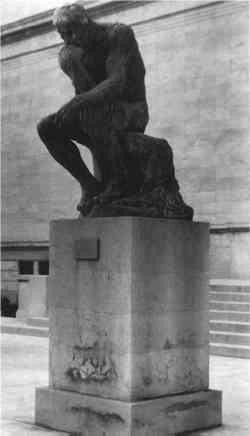TWENTY-FIVE YEARS AFTER THE BOMB: MAINTAINING CLEVELAND'S THE THINKERBRUCE CHRISTMAN
2 HISTORY OF TREATMENT, 1916–1970Records about the care of The Thinker come from three sources—the museum's archives, the curatorial records, and Conservation Department records. As might be expected, over a halfcentury these records are uneven and often sketchy. In the early years, day-to-day records and correspondence document the treatment the sculpture received during the administration of Frederick Whiting, the museum's first director (May 1913–August 1930). Records of treatment stop in 1925. The museum's Conservation Department was established in 1958, and before that date conservation work was undertaken by a number of outside conservators, notably William Suhr and Rostislav and S. N. (Nicky) Hlopoff. Information presented here also comes from personal communications with the late Frederick Hollendonner, former chief conservator, and with Superintendent Victor Kavosic, Cleveland Police Department, and from direct observation of coating procedures carried out at the museum. The Cleveland Museum of Art acquired The Thinker in 1917 (1917.42), one year after the museum opened its doors, as a donation from Ralph King. First displayed inside in the rotunda (fig. 1), within several months the sculpture had been moved outside to the south entrance of the museum (fig. 2). In a letter dated February 2, 1918, to Miss Anna Seaton-Schmidt, a pupil and friend of Rodin, Whiting explained this move.
Anna Seaton-Schmidt replied on February 7, 1918, expressing her delight that the museum had been fortunate enough to acquire The Thinker. As to the sculpture being placed outdoors, she wrote: She emphasized in another paragraph: “Above all it must be high. Even the one in front of the Pantheon is not high enough, but that could not be helped.” Once the sculpture was outside, Whiting noticed problems with the patina almost immediately. Two letters provide insight regarding the appearance of the original patina. In a letter dated October 9, 1917, to Malvina Hoffman, another student and friend of Rodin, Whiting wrote: Whiting went on to ask what Rodin would have wanted under the circumstances. Unfortunately, Malvina Hoffman's reply does not exist in the archives. The color of The Thinker is again mentioned in a letter to Purdy of the Gorham Company, dated October 22, 1917. “The large bronze replica of ‘The Thinker’ by Rodin which Mr. Purdy would become a key player, advising the museum on care for the sculpture. Letters between him and Whiting, from 1917 to 1921, are the earliest records regarding the care of the sculpture. On October 24, 1917, Purdy recommended: Whiting's reply, on November 2, sheds some light on this hand rubbing method: On October 31, Purdy instructed:
By June 1920, Purdy had changed his thinking on the care of outdoor bronze sculptures and advised the museum to apply wax to The Thinker. On June 10, Whiting described the new stone pedestal for The Thinker as already somewhat discolored by the bronze figure and asked if the wax would stop the staining of the stone base. He also complained that the figure looked dull. Could the wax be buffed? In Purdy's reply, dated June 24, Purdy asserted: “The wax coat should prevent further discoloration By April 1921, Whiting asked if Purdy would be in Cleveland in the near future “as there seems to be a constant running of the color, despite the treatments with the wax preparation, and the artificial stone base is fast becoming a greenish color from this cause. We do not object to the discoloration of the base, but it seems to indicate a deterioration of the bronze, which may be disastrous in time, if allowed to continue.” In 1921, Whiting inquired about purchasing more wax from Gorham Company and was reassured by Purdy that applying another coat of wax would cause no harm. After 1925, there are no records on the routine care of The Thinker in either the archives or the curatorial files. It is not clear why the records suddenly stop at this point. Frederick Whiting remained as director until August 1930 and it is unlikely that problems with The Thinker stopped suddenly or that Whiting's concern was any less. Perhaps Purdy retired from Gorham Company, or more likely the written correspondence was replaced by the telephone. In any case, at some later date the art handlers were sent outside with Gorham Company's AB Mixture—a petroleum-based product—and instructed to coat the sculpture with this material.1 This treatment was certainly being carried out from the 1950s onward. The museum's second director, William Milliken (August 1930–March 1958), may have started this practice, perhaps advised by the Gorham Company, which was marketing a new product. It is not clear how often the oil was applied to the sculpture. By the late 1970s the application of the AB Mixture was somewhat sporadic. The product applied to the sculptures was also changed at this point because AB Mixture was no longer available. Birchwood-Casey's Sheath Rust Preventive was used and is a similar, although more sophisticated, product containing corrosion inhibitiors.2 The results of these past treatments ranged from little to moderate protection for The Thinker. The earliest treatment recommended by Purdy—rubbing the sculpture with the hands and a cloth–seems to have been more aesthetic than truly protective. Purdy did not elaborate on how this rubbing treatment would stop corrosion. It seems that several things—both aesthetic and protective—may have happened with this treatment. The rubbing of the bronze surface may have removed dirt and pollutants as well as any residual patination chemicals not carefully washed from the bronze. The oil from the hands would help saturate the surface, thus making it appear more visually integrated. Oil from the hands may also have imparted some protection from water. However, this treatment would also have introduced salts and acids that, over the long run, could not have been beneficial. One can only speculate that Purdy had observed areas of bronze sculptures that had developed a lustrous patina from constant handling and formed the opinion that rubbing with the hands was good for the bronze. The composition of Purdy's wax was not given, but it must have provided more protection from the elements than the hand and cloth rubbing. He recommended that it be applied twice a year but did not recommend heating the wax or the sculpture. The protection given by It is evident that as long as the oil stayed in place, it did provide a modest amount of protection for the bronze. Unfortunately the various protective coatings do not seem to have been applied in a routine and systematic way. So, the protection of The Thinker from weathering has been uneven. It is clear that The Thinker would have been better preserved if it had been attended to on a more regular schedule. Purdy's influence on the treatment of outdoor bronze sculptures should not be underestimated. From the references in the correspondence, he was obviously concerned about preservation and was influential at several levels. He described his methods at a Metropolitan Museum of Art conference in the spring of 1917. While little is known about this meeting, it seems likely that representatives from many of the major museums in this country attended. Purdy was also involved in a project with Colonel Harts of the Bureau of Weights and Measures to preserve public monuments. At this time they were promoting the hand-rubbing method. Purdy also seems to have been speaking to artists, specifically to Auguste Rodin. It is not known if he expressed his views on preservation to Rodin, but he had close ties to the sculptor as he essentially acted as a dealer for him. |

